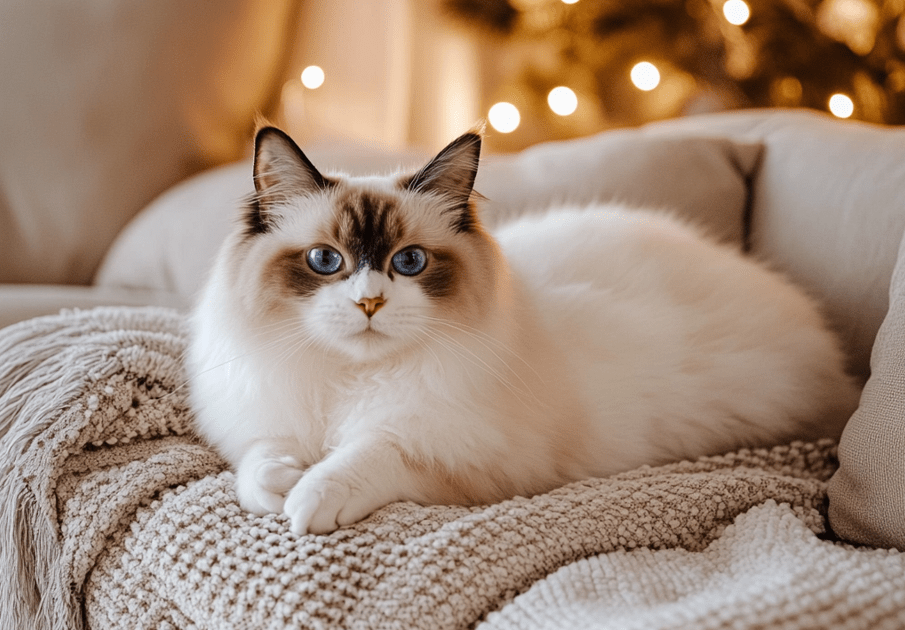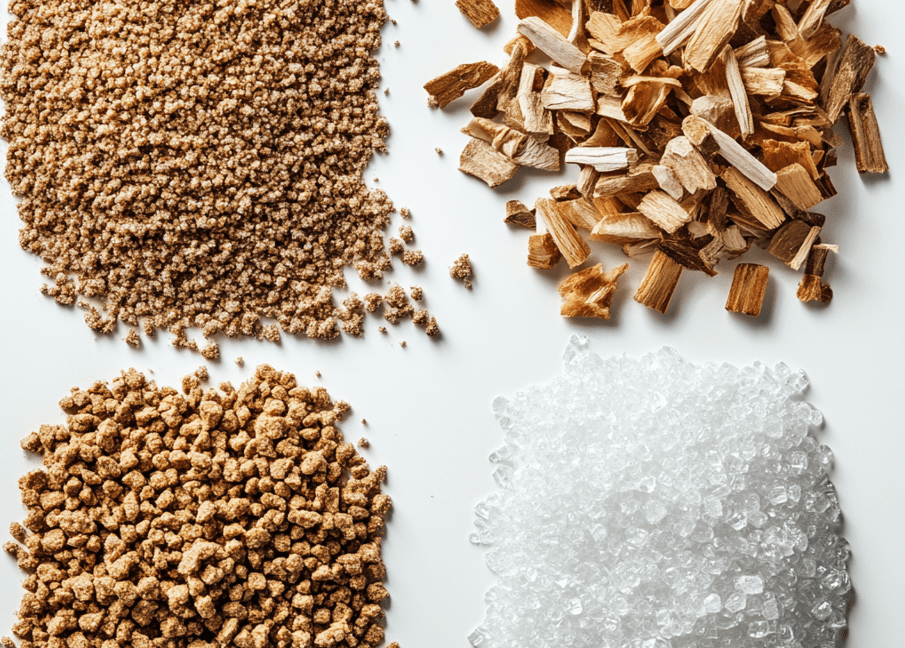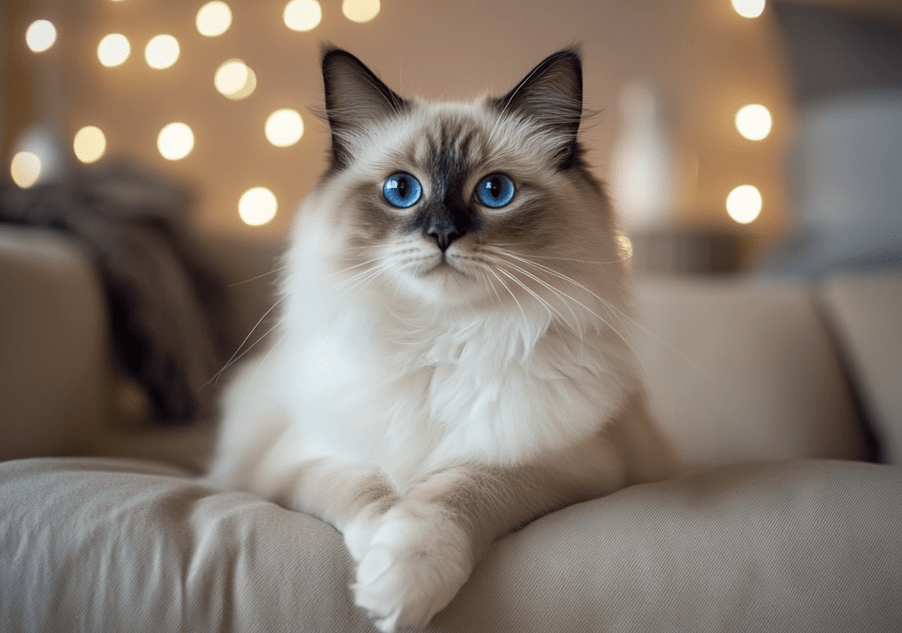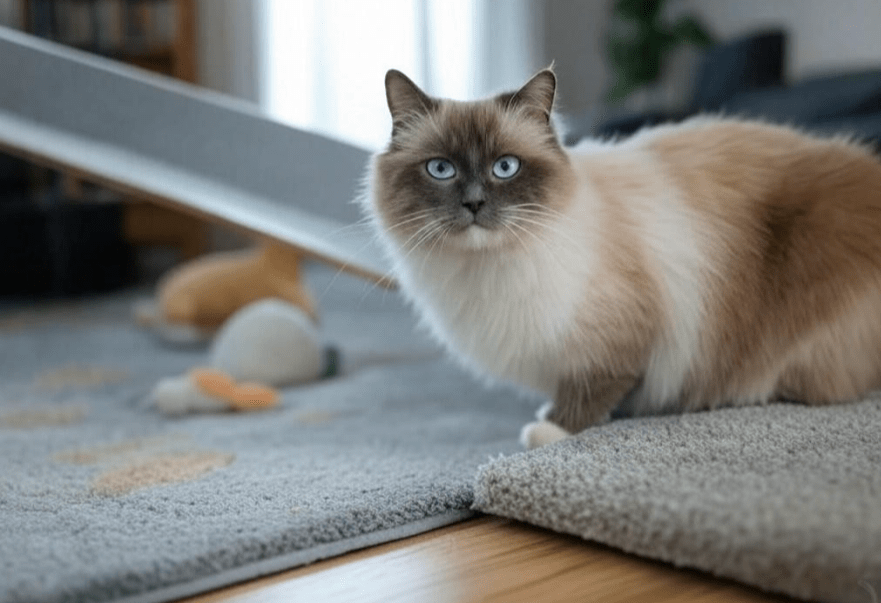
Ragdoll cats, with their plush coats and gentle personalities, are a joy to own, but their laid-back nature can make them prone to weight gain. Choosing the best diet for Ragdoll cats is essential to keep them healthy and prevent obesity, which can lead to serious health issues like diabetes and joint problems. A Ragdoll cat’s diet needs careful consideration to meet their unique nutritional requirements while maintaining an ideal weight. This comprehensive guide explores the optimal diet for Ragdolls, offering practical tips, expert insights, and strategies to ensure your cat thrives without packing on extra pounds.
From understanding their nutritional needs to creating a feeding routine, this article is your ultimate resource for keeping your Ragdoll fit, active, and happy. Whether you’re a new owner or looking to refine your cat’s diet, you’ll find everything you need to know here.
Why Obesity is a Concern for Ragdoll Cats
Ragdolls are a large breed, with males weighing 12–20 pounds and females 8–15 pounds. Their size, combined with a relaxed temperament, makes them susceptible to obesity, especially if their diet and activity levels aren’t managed. Obesity in Ragdolls can lead to:
Joint Issues: Excess weight strains hips and knees, worsening conditions like arthritis.
Diabetes: Overweight Ragdolls are at higher risk for insulin resistance.
Heart Disease: Obesity can exacerbate hypertrophic cardiomyopathy (HCM), a common Ragdoll health concern.
Reduced Lifespan: Carrying extra weight can shorten a Ragdoll’s life expectancy and lower their quality of life.
Preventing obesity starts with the best diet for Ragdoll cats, tailored to their age, activity level, and health status. By feeding them appropriately, you can help them maintain a lean physique and avoid these risks.
Understanding Ragdoll Cats’ Nutritional Needs
Ragdolls, like all cats, are obligate carnivores, meaning their diet must be high in animal-based proteins and low in carbohydrates. Their nutritional needs evolve through life stages, but the core requirements remain consistent. Here’s what a Ragdoll’s diet should include:
1. High-Quality Protein
Protein supports muscle development, organ function, and energy. Ragdolls need diets with at least 30–40% protein from animal sources like chicken, turkey, or fish.
Why It Matters: Protein maintains their large, muscular frame and supports their playful nature.
Sources: Look for foods listing meat, poultry, or fish as the first ingredient.
2. Moderate Fats
Fats provide energy and support skin and coat health. Aim for 15–20% fat in their diet, ideally from sources like fish oil or chicken fat.
Why It Matters: Fats keep their coat glossy but must be balanced to prevent weight gain.
Sources: Omega-3 and omega-6 fatty acids are ideal for Ragdolls.
3. Low Carbohydrates
Cats don’t require high carbs, as they metabolize protein and fat for energy. Diets with less than 10% carbohydrates help prevent obesity.
Why It Matters: Excess carbs can lead to fat storage, especially in less active Ragdolls.
Sources to Avoid: Fillers like corn, wheat, or soy offer little nutritional value.
4. Essential Nutrients
Ragdolls need specific vitamins and minerals, including:
Taurine: Vital for heart and eye health, especially given their HCM risk.
Vitamin A and D: Support vision, immunity, and bone health.
Calcium and Phosphorus: Promote strong bones and teeth.
5. Hydration
Ragdolls are prone to urinary issues, so adequate water intake is crucial. Wet food or water fountains can encourage hydration.
Why It Matters: Proper hydration supports kidney function and prevents urinary crystals.
Tip: Mix wet and dry food to boost moisture intake.
Choosing the Best Diet for Ragdoll Cats
Selecting the right food involves balancing quality, nutritional content, and your Ragdoll’s preferences. Here’s how to choose the best diet for Ragdoll cats to prevent obesity:
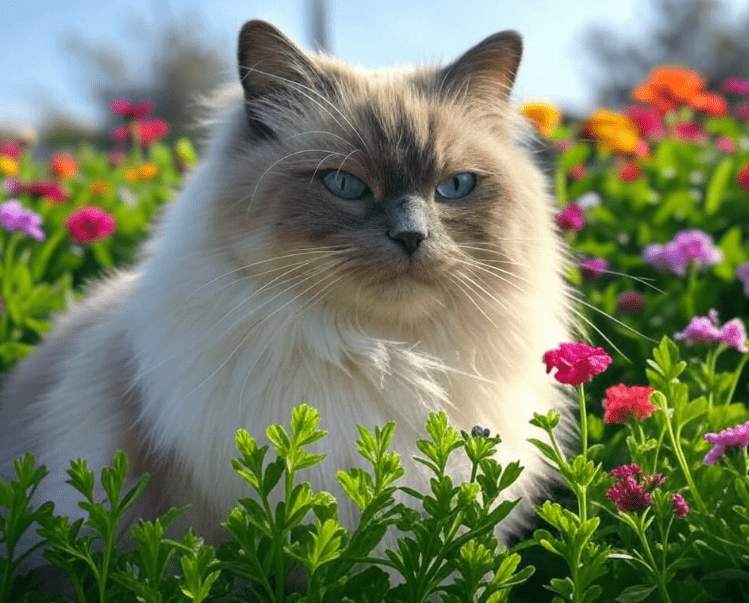
1. Wet Food vs. Dry Food
Both wet and dry foods have benefits, but a combination often works best for Ragdolls.
-
Wet Food:
-
Pros: High moisture content (70–80%), supports hydration, lower in calories per ounce, and often more palatable.
-
Cons: More expensive, requires refrigeration, and can contribute to dental plaque if not paired with dry food.
-
Best For: Ragdolls prone to urinary issues or those needing portion control.
-
-
Dry Food:
-
Pros: Convenient, cost-effective, and promotes dental health through chewing.
-
Cons: Lower moisture (10%), higher calorie density, and can lead to overeating if not measured.
-
Best For: Active Ragdolls or as a supplement to wet food.
-
-
Recommendation: Feed a mix of 70% wet food and 30% dry food to balance hydration, nutrition, and dental health. Adjust ratios based on your cat’s needs and vet advice.
2. Grain-Free vs. Grain-Inclusive
Grain-free diets are popular, but they’re not always necessary unless your Ragdoll has allergies.
-
Grain-Free:
-
Pros: Lower carb content, mimics natural diet, suitable for sensitive stomachs.
-
Cons: May be higher in fat, not inherently better for weight control.
-
-
Grain-Inclusive:
-
Pros: Can include nutrient-rich grains like rice or oats, often more affordable.
-
Cons: High-carb grains like corn or wheat can contribute to weight gain.
-
-
Recommendation: Choose grain-free if your Ragdoll has sensitivities; otherwise, opt for low-carb, grain-inclusive foods with minimal fillers.
3. Life Stage-Specific Diets
Ragdolls have different needs at various ages:
Kittens (0–12 months): High-protein, high-calorie diets to support growth. Feed 3–4 times daily.
Adults (1–7 years): Balanced diets to maintain weight and health. Feed 2–3 times daily.
Seniors (7+ years): Lower-calorie, joint-supportive diets to prevent obesity and support mobility. Feed 2–3 times daily.
Recommendation: Select foods labeled for your Ragdoll’s life stage, adjusting portions as they age.
4. Prescription Diets
If your Ragdoll has health issues like obesity, urinary problems, or HCM, your vet may recommend a prescription diet.
Examples: Hill’s c/d for urinary health, Royal Canin Weight Control for obesity.
Why It Matters: These diets address specific needs while preventing weight gain.
How to Prevent Obesity in Ragdolls Through Diet
Obesity prevention requires a strategic approach to feeding, portion control, and lifestyle. Here’s how to implement the best diet for Ragdoll cats to keep them lean:
1. Measure Portions Accurately
Overfeeding is a common cause of obesity. Use a measuring cup or scale to portion food based on your Ragdoll’s ideal weight.
-
How to Calculate:
-
Determine their ideal weight (consult your vet; typically 10–15 pounds for females, 12–20 for males).
-
Check food packaging for calorie content and daily feeding guidelines (e.g., 20 calories per pound of ideal weight for maintenance).
-
Adjust portions based on activity level and weight trends.
-
-
Example: A 12-pound Ragdoll needs ~240 calories daily. If their food has 100 calories per 3-ounce can, feed 2.4 cans (split into 2 meals).
2. Establish a Feeding Schedule
Free-feeding (leaving food out all day) can lead to overeating, especially with dry food. Instead, feed measured meals on a schedule.
Kittens: 3–4 small meals daily.
Adults/Seniors: 2–3 meals daily, spaced 8–12 hours apart.
Tip: Use puzzle feeders or timed feeders to slow eating and engage their mind.
3. Limit Treats
Treats should account for no more than 10% of daily calories to avoid weight gain.
Healthy Options: Freeze-dried meat treats, low-calorie catnip treats.
Tip: Break treats into tiny pieces to stretch their use and reward without overfeeding.
4. Monitor Weight Regularly
Weigh your Ragdoll monthly using a digital pet scale to catch weight gain early.
Ideal Body Condition: You should feel ribs with slight pressure and see a defined waist from above.
Action: If weight creeps up, reduce portions by 10% and consult your vet.
5. Encourage Hydration
Adequate water intake supports metabolism and prevents overeating driven by thirst.
Strategies:
-
-
Provide a cat water fountain to encourage drinking.
-
Mix wet food with water for extra moisture.
-
Place multiple water bowls around the house.
-
Sample Meal Plan for a Ragdoll Cat
Here’s a sample daily diet for a healthy, 12-pound adult Ragdoll to prevent obesity (~240 calories/day):
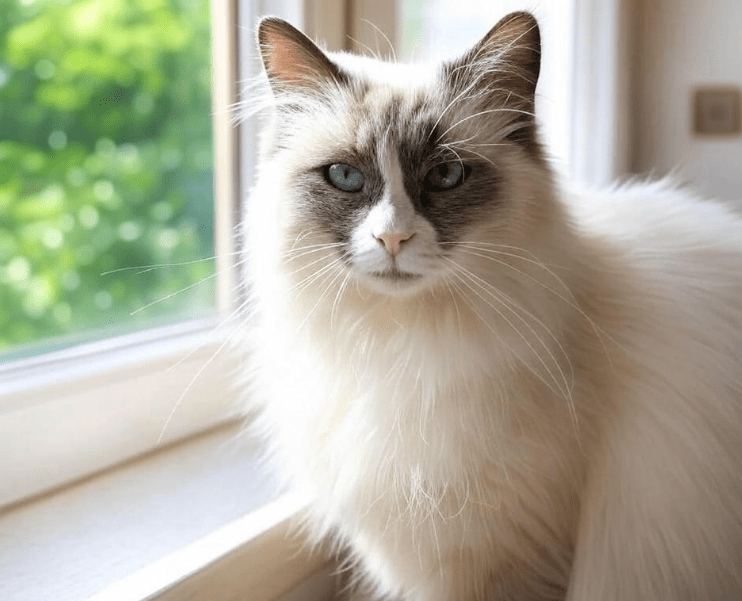
-
Morning (7 AM):
-
1.5 oz wet food (50 calories, high-protein chicken formula).
-
1/8 cup dry food (40 calories, low-carb formula).
-
-
Evening (7 PM):
-
1.5 oz wet food (50 calories, fish-based formula).
-
1/8 cup dry food (40 calories, same as morning).
-
-
Treats (Throughout Day):
-
2–3 small freeze-dried treats (20 calories total).
-
Adjustments:
-
Increase wet food to 2 oz per meal if reducing dry food.
-
For weight loss, cut total calories by 10–20% under vet guidance.
Note: Always transition to new foods gradually over 7–10 days to avoid digestive upset.
Common Dietary Mistakes to Avoid
Even well-meaning owners can make mistakes that contribute to obesity. Here’s what to watch out for:
Overfeeding Dry Food: Dry food’s high calorie density makes it easy to overfeed. Measure carefully.
Ignoring Calorie Content: Not all foods are equal; check labels to ensure portions match calorie needs.
Feeding Human Food: Table scraps like cheese or fatty meats add unnecessary calories and can be toxic.
Inconsistent Schedules: Irregular feeding can lead to begging or overeating. Stick to a routine.
Assuming Activity Compensates: Ragdolls are less active indoors, so diet is the primary weight control tool.
Supporting Diet with Exercise
While diet is critical, exercise complements the best diet for Ragdoll cats by burning calories and keeping them agile.
Daily Play: Engage your Ragdoll for 15–30 minutes with feather wands, laser pointers, or balls.
Interactive Toys: Puzzle feeders or treat-dispensing toys stimulate mental and physical activity.
Vertical Spaces: Cat trees or shelves encourage climbing, which is great for larger breeds like Ragdolls.
Tip: Rotate toys weekly to maintain interest and prevent boredom.
Special Considerations for Ragdoll Diets
Certain health conditions or life stages require dietary tweaks. Here’s how to adapt:
1. Kittens
Needs: High-calorie, nutrient-dense food to support rapid growth.
Recommendation: Feed kitten-specific formulas with extra protein and fat until 12 months.
2. Seniors
Needs: Lower calories to match reduced activity, plus joint-support nutrients like glucosamine.
Recommendation: Choose senior formulas with moderate protein and added omega-3s.
3. Neutered/Spayed Cats
Needs: Reduced calories post-surgery due to slower metabolism.
Recommendation: Cut portions by 10–20% and monitor weight closely for 6 months after surgery.
4. Cats with Health Issues
HCM: Low-sodium diets to reduce heart strain.
Urinary Issues: High-moisture diets to prevent crystals.
Obesity: Vet-prescribed weight-loss diets with reduced calories.
Tip: Always consult your vet before changing diets for medical conditions.
Expert Tips for Feeding Ragdoll Cats
Veterinarians and feline nutritionists offer these insights to optimize your Ragdoll’s diet:
Read Labels Carefully: Choose foods with named meat sources (e.g., “chicken” vs. “meat by-products”) and minimal fillers.
Rotate Proteins: Offer different protein sources (chicken, turkey, fish) to prevent sensitivities and maintain interest.
Work with Your Vet: Annual checkups can assess weight, dental health, and nutritional needs.
Avoid Raw Diets Unless Expert-Guided: Raw feeding carries risks like bacterial contamination and nutrient imbalances without proper formulation.
Stay Consistent: Sudden diet changes can cause stress or digestive issues; transition slowly.
Conclusion
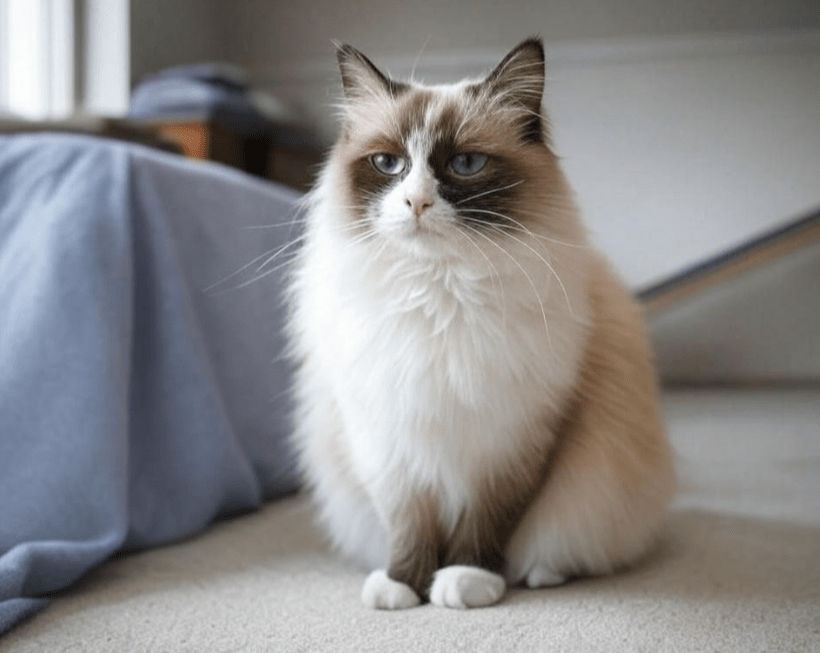
Choosing the best diet for Ragdoll cats is the cornerstone of preventing obesity and ensuring a long, healthy life. By prioritizing high-protein, low-carb foods, measuring portions, and pairing diet with exercise, you can keep your Ragdoll at an ideal weight. This guide’s practical tips—from selecting wet and dry food to avoiding common pitfalls—empowers you to make informed choices tailored to your cat’s needs. With regular vet checkups, a consistent feeding routine, and a commitment to their well-being, your Ragdoll will stay fit, active, and ready to share their affection for years to come.


